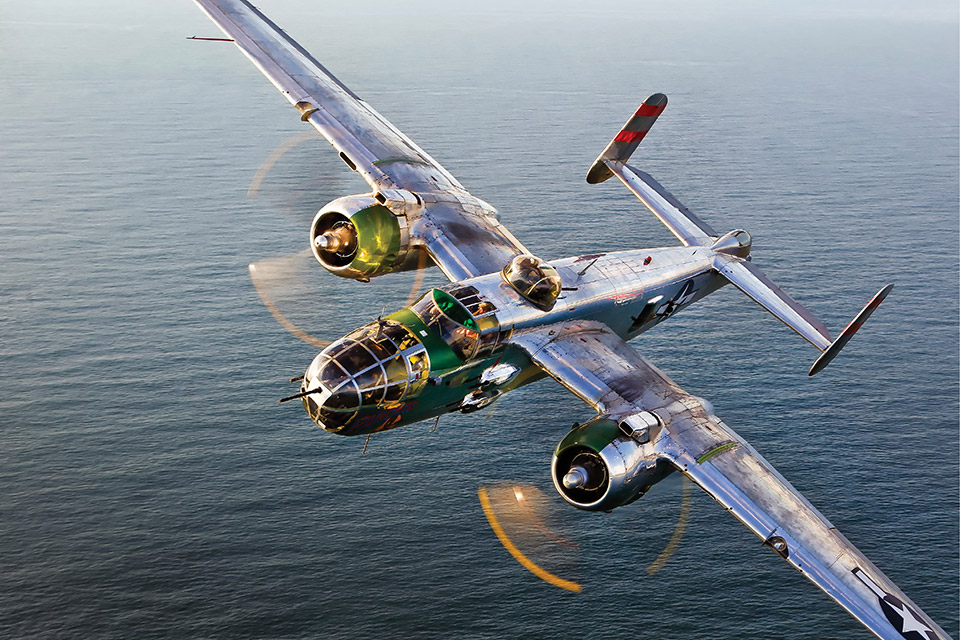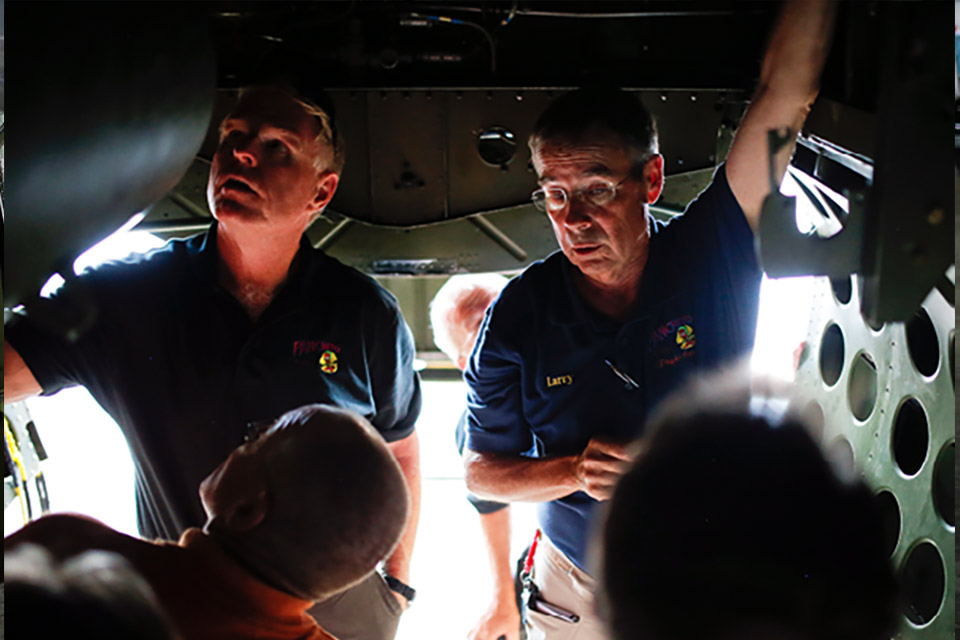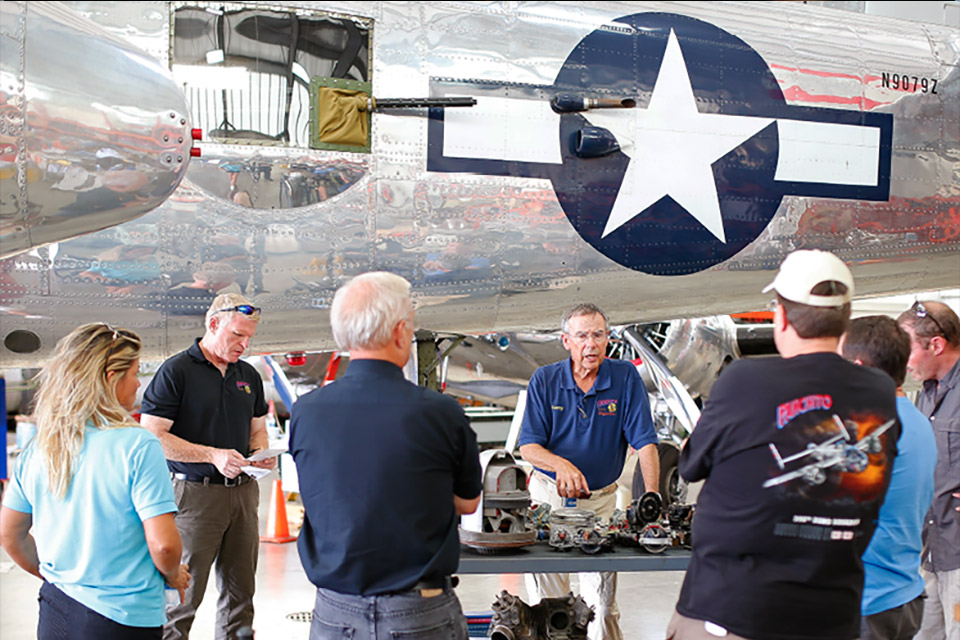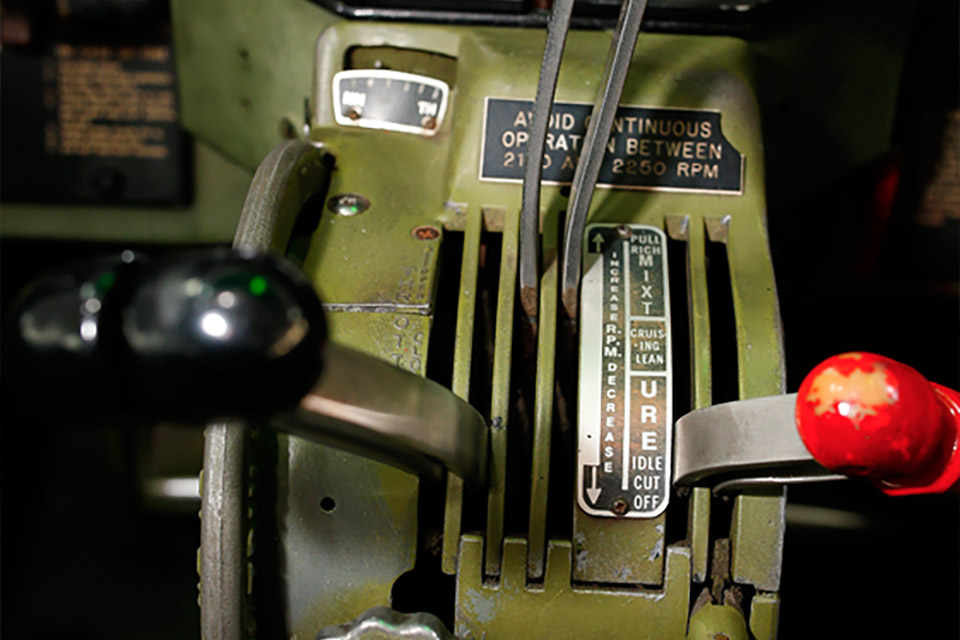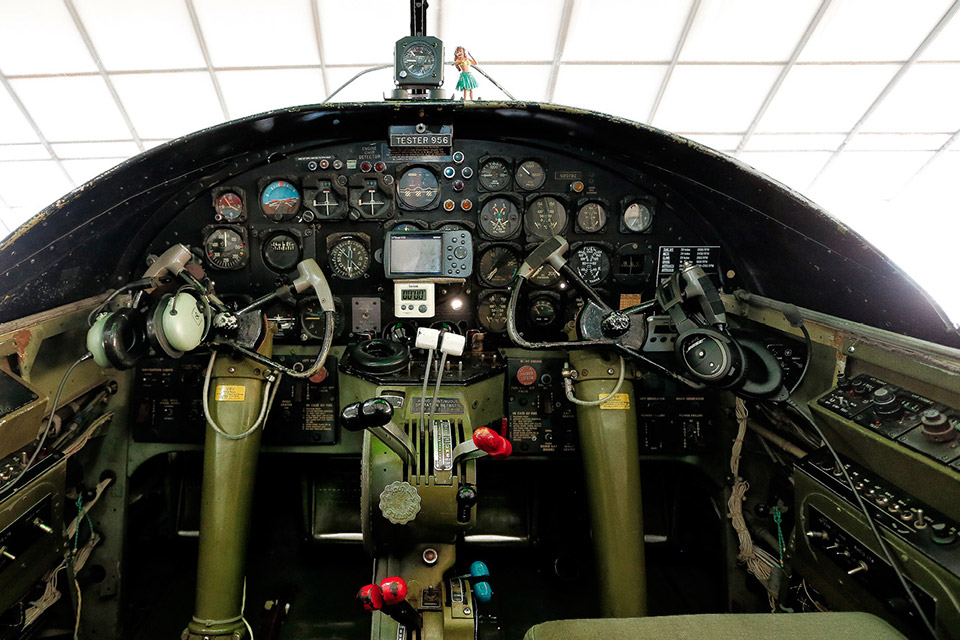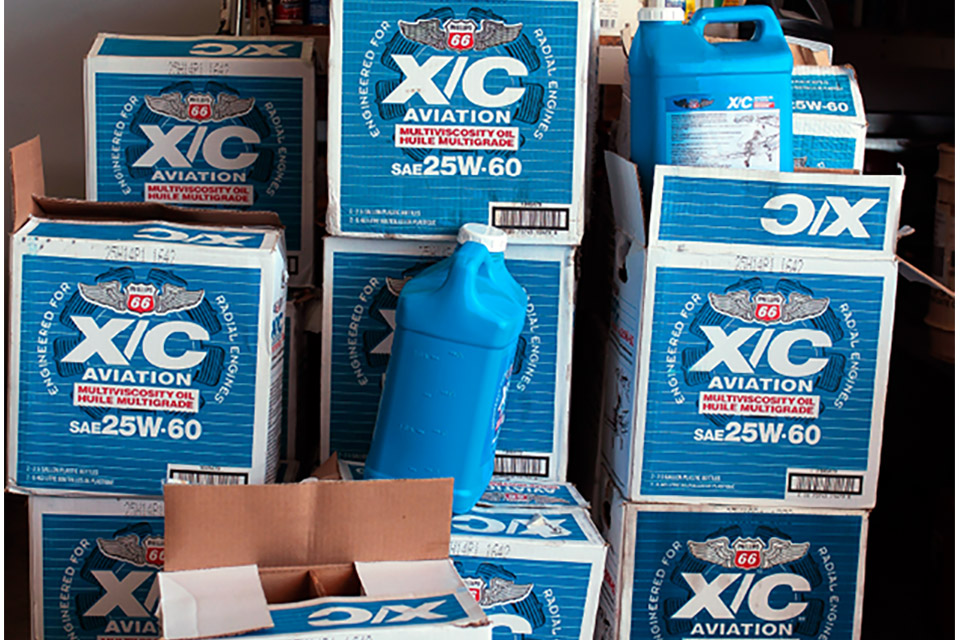Flying through history
As it turns out, the tales are true. The stories of how you don’t taxi a B–25—instead you herky-jerky your way to the runway; a cockpit so loud it will make your ears bleed; so much vibration you have to lock down the engine controls every second you’re not moving them. Of course, especially during training, you’re moving the controls all the time to keep the dueling Wrights happy—so that last one doesn’t count so much.
And although I found it a difficult airplane to fly well and nearly impossible to taxi well, I was almost overwhelmed with the feeling of nostalgia and honor at the chance to fly the iconic North American B–25 Mitchell bomber. Earning a second-in-command type rating in Panchito, a 1944 TB–25N, gave me a whole new level of respect and admiration for those young men of the Greatest Generation who climbed aboard these mechanical marvels and launched across oceans and continents with the most basic of navigation gear, many of them never to return home.
The pilot and co-pilot likely would be in their early to, at the most, mid-20s; the crew younger than that. The same age as my own children. They would put their faith and lives in the hands of that left-seater, who likely had flying hours measured only in the hundreds—and perhaps none of them yet in combat.
Lifting off from Runway 4 at Delaware’s Sussex County Airport, you can immediately see the Atlantic beach just ahead. Leveling off at 1,000 feet agl I could imagine I was off on some bombing mission, ascending from an airport in the Mediterranean. Or even a Pacific airstrip, destination a Japanese-held island, although there were decidedly few palm trees in sight. As we made takeoff after takeoff, hundreds of spectators and players at a high school baseball tournament just off the end of the runway gawked up at our roaring passage every time. What are they thinking? I wondered. Are they in awe of this mighty machine, or simply annoyed by the noise?
I hope it is the former, as the B–25 is the most famous of the twin-engine medium bombers of World War II and about the only combat airplane to see action in every theater of the war. With nearly 10,000 built, the Mitchell was everywhere, in service for England, France, Holland, Canada, Australia, China, the Soviet Union, and Brazil. But, of course, one mission in particular cemented the bomber’s place in history: the Doolittle Raid on Tokyo.
On April 18, 1942, 16 B–25s struggled off the deck of the USS Hornet to bomb Tokyo. Forced to launch earlier than planned because of an enemy sighting, the pilots knew their chances of a successful landing were small—yet they went anyway, clawing their way into history off that pitching 467-foot deck, wing tips clearing the superstructure by no more than six feet. Their success was but a flea bite to the Japanese war machine, but the psychological victory helped to turn the direction of the war. Japan was forced to recognize its homeland vulnerabilities and had to pull back. The United States, bolstered by the news, amped up its efforts even more, and the tide soon was turned.
More than 70 years later, only a couple dozen of these icons still ply the skies, their guns long since silenced; their bomb bays carrying only replica bombs. But the smell of the avgas and oil and sweat, the vibrations, and the sunlight streaming through the green-tinted overhead are as real as ever.
With thousands of flight hours in more than a hundred different aircraft models, I’m stumped and flummoxed about how to usher this old airplane through the air with any finesse at all. How in the world did they do it?
“Become one with the airplane,” coaches Paul Nuwer from the right seat, like some Zen instructor, as my stop-to-stop rudder movements attempt to caress the lumbering machine down the taxiway. I’m fearful of even touching the brakes, because I have seen the effect when my training partner, Michael Horner, tried it. Even a slight nudge of the brakes jerks the airplane one way or another—what instructors call the conga or the Baghdad Dance. There’s no feedback through the brakes, the pedals offering only about a half-inch of travel—and each side responding differently to the same application of pressure.
At first I think Horner, a corporate jet pilot, must be putting me on as I observe from the jump seat. No, I learn later, the brakes are just that cantankerous. Mostly you use the rudders as best you can to direct the big bomber, but occasionally you’ll need a touch of brake when the castering nosewheel has you heading for the ditch—and when you do, everyone will know it.
Nuwer is our flight instructor for the weekend second-in-command course at the Delaware Aviation Museum Foundation, which owns Panchito. Horner and I are among the first classes offered by the museum, a way to allow new generations to experience the famed bomber, as well as to offset some of the expenses of flying and maintaining it. Nuwer recently earned his designated examiner status in the B–25, allowing him to issue pilot-in-command type ratings, which can be had for an investment of about $40,000—a price that includes about 11.5 flight hours.
For Horner and me, however, there is no checkride, just an amazing weekend of camaraderie, ground school, hangar flying, and experiencing a legendary airplane—plus a new pilot certificate endorsement that may play well in a bar someday. Oh, and a flight suit as well. Price for the SIC course is $5,500. There are lower-priced orientation flight options, as well.
Crawling around in, under, and on top of Panchito for the preflight, I quickly discover the benefits of the jumpsuit around an airplane that burns some three or four gallons of oil an hour, and deposits about that same amount on the airframe.
Our weekend experience starts with a full day of ground school, about half of it in a classroom studying history, systems, and limitations. The other half is spent at the airplane, seeing those systems in operation and understanding the workings of a design that first flew in 1939.
The next day while attempting to taxi, I recall Larry Kelley’s explanation of the brake system—and the $8,000 cost for a set of bronze rotors. “Brakes are a four-letter word for us,” Kelley says. As the owner of the museum and Panchito, it’s up to him to pay the bills, using his own money and whatever he can earn through donations and, now, training fees. With the once-ready supply of WWII-surplus parts now all but used up, warbird enthusiasts often must now have parts custom made. A set of main landing-gear tires, installed: about $11,000. Another reason to be careful with the brakes.
After watching Horner fly, it’s finally my turn. I climb up the ladder in the forward belly hatch and maneuver my way through the “student compartment,” past the jump seat and into the left seat. The cockpit is roomy and the panel surprisingly well laid out, but festooned with buttons and knobs for controlling all sorts of systems—including the four .50-caliber machine guns, two on each side—at the command of the pilot. And, of course, the hydraulically operated bomb bay doors. All in all, a B–25 may have as many as 18 .50-caliber Browning M-2 machine guns, including the nose and tail gunners, the turret and waist gunners; Panchito had 13. The bomb bay can carry up to 3,000 pounds of ordinance, or if range is the goal, an extra fuel tank. Above the bomb bay and just aft of the student compartment is a crawl space to the aft compartments for moving around in flight. On the ground, the aft gunners can enter via their own belly hatch.
Upon starting the two Wright R-2600 radial engines, I quickly realize why it’s a two-pilot airplane, as hands fly all over the place: Boost pumps On, punch the Energize button to engage the starter, count six blades, turn on both mags, primer switch to On, mesh the ignition vibrators, and hold primer on until start—while moving the mixture to Cruise Lean. Mostly thanks to Nuwer’s deftness, the first engine shakes itself awake, the 14 cylinders seeming to need more coffee early on this Sunday morning. Soon Number 2 is spinning and we’re lurching to Runway 4.
Staring at 5,500 feet of smooth, level pavement, I count a few runway stripes to estimate the length of the Hornet deck and marvel again at the Raiders’ achievements. They used full flaps. We use one-quarter, and gently advance the throttles to just 39.5 inches of manifold pressure, instead of the maximum of 44 inches; superchargers, each with two stages, provide the extra boost. With engine overhauls running some $90,000 apiece, the foundation treats the old girl gently. Besides, no one except a photographer is shooting at us today, so we’re in no big hurry.
With 13 feet of propeller just a couple of feet from my head, the 1,700-horsepower engines at first just seem to create noise and vibration, but soon the B–25 gathers herself up and we’re rolling. Passing about 85 mph is the time for a slight rotation; allow the airplane to lift off at about 120 mph and then quickly level off to allow the speed to build to at least 145 mph before climbing away.
“They didn’t know anything about VMC,” Nuwer shouts as we pass the speed at which the airplane might be controllable on one engine. We’re soon climbing away as Nuwer busies himself raising the gear, setting the power to METO—maximum except takeoff, which is 2,400 rpm and 34 inches—raising the flaps, futzing with the hydraulically actuated cowl flaps, and shutting off the boost pumps. Meanwhile, I’m watching those shrinking baseball players, their heads cranked skyward like baby birds waiting for their mamas. Some of them wave. I wave back.
Throughout our climb to 3,500 feet, Nuwer is busy with power management, moving the throttles and props for each engine at the same time, unlike the usual advice for a conventional engine. The B–25 likes its hydraulics, with everything from flaps and gear to bomb-bay doors, cowl flaps, carburetor air filter doors—and, of course, those brakes—powered by that important system.
We practice a few maneuvers and some slow flight. Nothing unusual here, except I’m reminded that this is a 26,000-pound airplane and feels like it, demanding two hands on the yoke at all times. It’s heavy in roll; lighter on pitch and yaw. Later, one of our approaches is single-engine and Nuwer reminds me that the minimum altitude for deciding to go around single-engine is 500 feet agl. You’re just not going to arrest that descent any later than that and still have enough time for the solo engine to limp you into a climb.
Preserving history
Panchito found its way to Kelley via a circuitous route. Built in 1944 as a B–25J, it never saw combat and ultimately landed at the Air Training Command in 1948. In 1954 it was converted to a TB–25N and served the Air National Guard before being retired to Davis-Monthan Air Force Base in 1958. It was sold a year later to a civilian for $2,100 and used as a fire bomber in Arizona and, later, as an orange-grove sprayer in Florida.
The Mitchell sat outside at a museum for years before Tom Reilly’s Flying Tigers Warbird Restoration Museum (nicknamed “Bombertown USA”) in Kissimmee, Florida, restored it in 1986 as Panchito, a B–25J that served in the 396th Bomb Squadron in the Central Pacific. The original Panchito was set for its thirteenth bomb run to Japan when the Japanese surrendered. Then, like so many others, it was flown to Clark Field in the Philippines and unceremoniously bulldozed into a ditch. Kelley bought the restored airplane in 1997.
For Kelley and his volunteers, including Calvin Peacock, Nuwer, and many others, keeping the airplane flying, maintained, and on display at public events is a labor of love—especially when they get the chance to fly disabled veterans, which is one of their causes. Given the operating costs, no one could blame them for parking the Mitchell in a hangar, but Kelley believes that seeing it in flight—and hearing it—are what connects people across the generations to the aviation effort of World War II, and reminds them of the great sacrifice made by so many. “When I go to the zoo, I don’t want to see a stuffed bear. I want to hear it roar,” he explains. And roar Panchito does, thanks to the crew at the Delaware Aviation Museum Foundation.
Fast facts
B-25J
Max speed | 275 mph
Max gross weight | 35,000 lbs
Max overload weight | 41,800 lbs
Service ceiling | 24,500 feet
Max range (auxiliary tanks) | 2,700 miles
Max fuel | 974 gal; 1,189 gal with bomb bay tank
Max oil | 79 gal, same amount as a full fuel load in a Bonanza
Typical crew | pilot, co-pilot, bombardier, turret gunner, waist gunner, tail gunner
Email [email protected]
To learn more about how to earn a second-in-command rating and get up close and personal with Panchito, visit the website.
Extra: View the video.

